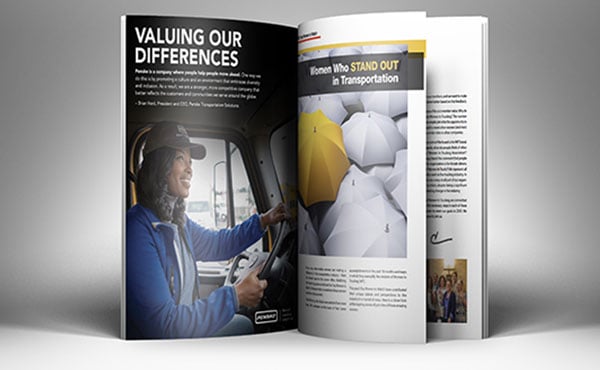Recruiting & Retaining Female Talent During the Great Resignation
by Women In Trucking Staff, on Oct 18, 2022 2:34:23 PM

The Great Resignation created a large vacuum of talent in the transportation workforce. Now, significant changes are being made throughout the industry in regards to recruitment efforts. Diversity and inclusion are taking the lead when it comes to finding new talent. However, the labor shortage and certain stigmas have left the well dry for many companies. The trucking industry has always been a resilient one, and companies are continuing to come up with new ways to attract and retain more women in leadership roles.
Roadblocks for Recruitment
 Shane Keller, Managing Director of Recruiting at Centerline Drivers, says it’s about representation. Oftentimes, there is the appearance that trucking doesn’t appeal to, or welcome, women into the field. He says between the low percentage of women in the trucking workforce, safety concerns, and the stigma that drivers are gone from home for months at a time, there are a number of factors that could add to the perception that it is not a woman-friendly industry.
Shane Keller, Managing Director of Recruiting at Centerline Drivers, says it’s about representation. Oftentimes, there is the appearance that trucking doesn’t appeal to, or welcome, women into the field. He says between the low percentage of women in the trucking workforce, safety concerns, and the stigma that drivers are gone from home for months at a time, there are a number of factors that could add to the perception that it is not a woman-friendly industry.
“Add that to simple things like imagery that only shows male truck drivers, and it’s easy to see why women may feel like the industry is not for them,” Keller says.
 Kelly Rooney, Senior Vice President, Chief People Officer at WM, says safety considerations for over-the-road opportunities, access to paid and safe training opportunities, family care challenges, lack of information, non-inclusive environments, and facilities not properly equipped to serve female drivers are just a few of the barriers that women face in the trucking industry.
Kelly Rooney, Senior Vice President, Chief People Officer at WM, says safety considerations for over-the-road opportunities, access to paid and safe training opportunities, family care challenges, lack of information, non-inclusive environments, and facilities not properly equipped to serve female drivers are just a few of the barriers that women face in the trucking industry.
“Societal expectations have pushed more kids into college instead of the trades and the number of people entering the trucking industry has been on the decline,” Rooney says. “Challenges within the industry, especially around compensation structures, have also made it less desirable to stay in the industry. Factors like pay structures that do not include paid training, overtime, or paid waiting time have made drivers reconsider driving roles.”
At FedEx Freight, the motto is that to grow in a career, it is critical for women to have examples and role models so they can see themselves in a role.
“We need to lead by example, tap into the female population, and encourage careers in this traditionally male industry,” says a human resources source at FedEx Freight.
Trucks with No Drivers
Keller says the driver shortage problem continues to plague the industry, and each year it seems to become more difficult for employers to find drivers.
“Centerline Drivers found in its annual State of Trucking survey that more than 70 percent of employers were having trouble finding drivers,” he says. “For many, this means that they have trucks sit for days – that increases costs and quickly impacts a company’s bottom line. The cost of having a truck sit empty is high. Our customers estimated the cost of a sitting truck is $500 to $1,500 per day, per truck. That’s a huge number.”
Keller says the industry is continuing to deal with more people exiting via retirement rather than entering. The demand placed by increased e-commerce created an increase in the need for professional truck drivers to move products. This demand for drivers created a churn within the market as drivers sought to better their income, benefits, and home time.
“They often made frequent job changes to better their individual situation,” he says. “The nature and lifestyle of the work can also be a factor, with hours, workplaces, and physical demands different than a typical corporate job.”
How Can You Change the Appearance of Trucking for Women
One way the industry can continue to recruit women is by providing and promoting opportunities that may overcome common concerns.
“For example, some may be intimidated by driving a large truck,” says one human resources executive at FedEx Freight. “Several years ago, FedEx Freight began investing heavily in lower-height straight trucks for enhanced maneuverability in residential areas, providing flexibility through our Class B driver program. Given the increase in e-commerce and record-setting volume, we identified an opportunity for future drivers to match this impressive growth. The addition of Class B drivers to utilize straight trucks taps into a new market of future drivers at FedEx Freight.”
Rooney says WM offers a lot of the benefits women seek in a trucking career. The company has multiple leadership training programs, paid training, family support, a paid tuition program, child and elder care assistance, and more.
“We have a People-First Culture where we strive to create a great place to work for all of our folks,” she says. “We have strategic partnerships with organizations that help bridge the gap between companies and available female talent such as The Mom Project and HirePurpose. We are constantly evaluating our benefit offerings to ensure they are attractive to women at all levels of the organization.”
Keller says one other key element that often gets overlooked is having women represented in all touchpoints with female truck drivers.
“That’s part of the reason Centerline Drivers has been able to increase its number of female drivers each year for the past three years,” says Keller. “We have more women in leadership, recruiting, and service center roles than many of our competitors. Plus, with policies like flexible schedules and programs in leadership and development and in-depth safety programs, we offer support to our drivers at every stop.”
The industry needs more positive stories about drivers, FedEx Freight says.
“We need to encourage people to consider the industry as a lucrative career path, and to have greater appreciation for the people who do these jobs,” the company says.
According to Keller, making drivers feel like they’re part of something while also offering family-friendly benefits will help keep female employees in the industry.
“Whether it’s something like Women in Trucking, who does a great job of connecting drivers with each other or making sure that the company recognizes its drivers and gives them opportunities for recognition, success and movement in their careers is important,” he says.
Diversity & Inclusion Efforts
FedEx Freight started the Women’s Business Resource Team as an employee-led group with a mission to promote the roles and contributions of female team members as well as provide recruitment, development, mentoring, and networking opportunities to members of the group.
Rooney says WM wants to make sure all their locations have supportive and inclusive leaders that want to cultivate a community and a culture based on caring.
“We are listening to our people and being responsive to what’s important to them,” she says. “We’re making continued investments in our people, facilities, fleet, and evolving our business…truck drivers are literally the foundation of our functioning society and are critically important.”
Keller says at Centerline, drivers are matched with their ideal opportunity. Through an engaging conversation, recruiting managers focus on matching skills, shift and equipment preferences, and lifestyle to open positions.
“It’s flexible and creative solutions like that that will help get more women into the industry,” he says.
According to Keller, the more women can picture themselves driving for a company, the more recruiting efforts will be effective. He says to stay away from using just one woman in recruiting materials. Use a variety of women, including all different shapes, sizes, and ethnicities.
“Aim to speak to women from numerous backgrounds,” he says. “Let them know that you want them and the uniqueness that they bring.”

This article was originally featured in Edition 2 of 2022 in our official magazine, Redefining The Road.
Like this kind of content?
As a member of the Women In Trucking Association, stay on top of emerging trends and business issues impacting transportation, logistics, and supply chain operations, learn the importance of gender diversity in the workplace and the need for more women drivers, and see best practices in encouraging the employment of women in the trucking industry. Learn More





